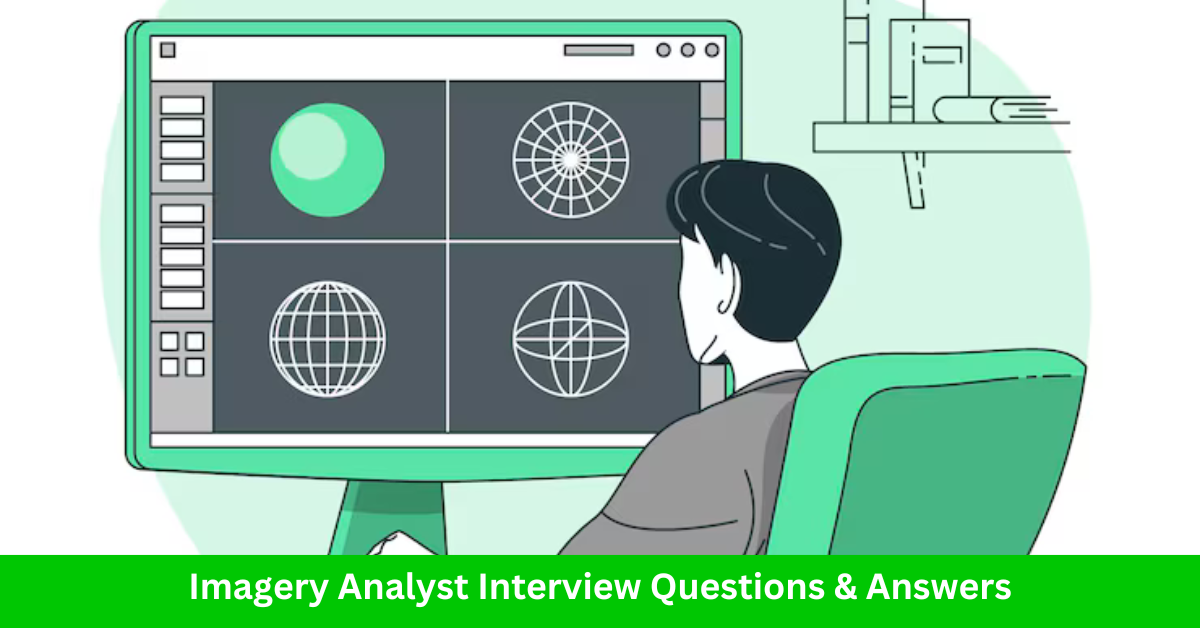Imagery analysis is a vital skill in sectors such as defense, intelligence, urban planning, and disaster management. An Imagery Analyst interprets data from aerial or satellite imagery to provide actionable insights. If you’re preparing for an interview for this role, having a solid grasp of the technical and analytical aspects is key. Here are the top 15 imagery analyst interview questions and answers to help you succeed.
15 Imagery Analyst Interview Questions & Answers
Here’s a comprehensive list of 15 Imagery Analyst Interview Questions & Answers along with detailed answers to help you prepare and impress your interviewers.
1. What is the primary role of an imagery analyst?
Answer:
An imagery analyst examines aerial or satellite images to identify patterns, extract information, and provide actionable intelligence for decision-making. Their insights are often used in fields like defense, agriculture, and disaster management.
2. What types of imagery data have you worked with?
Answer:
Common types of imagery data include:
- Optical imagery: For high-resolution visuals.
- SAR (Synthetic Aperture Radar): For capturing data in all weather conditions.
- Multispectral and hyperspectral imagery: For analyzing vegetation, minerals, and water quality.
- Thermal imagery: For detecting heat signatures.
3. How do you process and analyze satellite imagery?
Answer:
The process includes:
- Acquiring the data from sources like Landsat, Sentinel, or commercial providers.
- Preprocessing (georeferencing, calibration, and atmospheric correction).
- Analyzing data using GIS and remote sensing software like ERDAS IMAGINE or ENVI.
- Generating actionable reports or maps.
Related Article: 15 Cartographic Designer Interview Questions
4. What is the difference between raster and vector data?
Answer:
- Raster data represents continuous data, such as imagery or elevation models, as pixels.
- Vector data represents discrete features like points, lines, and polygons, such as roads or boundaries.
5. What tools and software are you proficient in for imagery analysis?
Answer:
I have expertise in:
- GIS software: ArcGIS, QGIS.
- Remote sensing tools: ERDAS IMAGINE, ENVI.
- Programming: Python and R for data analysis.
- Satellite data platforms: Google Earth Engine, USGS Earth Explorer.
Related Article: Top 15 Cartography Technician Interview Questions and Answers
6. Can you explain the concept of image classification?
Answer:
Image classification is the process of categorizing pixels in an image into different classes or themes, such as vegetation, water, or urban areas. It can be done using supervised or unsupervised methods.
7. How do you ensure the accuracy of your analysis?
Answer:
Accuracy is ensured through:
- Validating data with ground truth observations.
- Performing accuracy assessments using confusion matrices.
- Regularly updating and calibrating analytical models.
Related Article: Top 15 Aerial Photogrammetrist Interview Questions & Answers
8. What is change detection in imagery analysis?
Answer:
Change detection identifies differences in a specific area over time using multi-temporal imagery. It is crucial for monitoring deforestation, urban expansion, or disaster impacts.
9. How do you handle large datasets in imagery analysis?
Answer:
To manage large datasets, I:
- Use cloud-based platforms like Google Earth Engine.
- Optimize workflows with batch processing.
- Employ high-performance computing for large-scale analysis.
Related Article: Top 15 Data Mapper Interview Questions & Answers
10. What is NDVI, and how is it used in imagery analysis?
Answer:
NDVI (Normalized Difference Vegetation Index) is a measure of vegetation health, calculated from multispectral imagery. It is widely used in agriculture and environmental monitoring.
11. What challenges have you faced in imagery analysis projects, and how did you overcome them?
Answer:
Challenges include dealing with poor image quality or missing data. I overcame these by preprocessing the data effectively, using alternative datasets, or applying interpolation techniques.
Related Article: Top 15 Map Maker Interview Questions & Answers
12. What is spatial resolution, and why does it matter?
Answer:
Spatial resolution refers to the size of one pixel in an image. Higher resolution means finer details, which are essential for tasks like urban mapping or small-scale feature detection.
13. How do you keep up with advancements in remote sensing and imagery analysis?
Answer:
I stay updated by:
- Attending webinars and conferences.
- Following publications like IEEE Geoscience and Remote Sensing.
- Enrolling in online courses on platforms like Coursera or Udemy.
14. Describe your experience with defense or intelligence-related imagery analysis.
Answer:
In my previous roles, I analyzed satellite imagery to identify potential threats, monitor troop movements, and assess terrain for operational planning.
Related Article: Top 15 Field Map Editor Interview Questions & Answers
15. What is the importance of metadata in imagery analysis?
Answer:
Metadata provides essential information about the image, such as acquisition date, resolution, and sensor type. This helps ensure accurate analysis and proper usage of the data.
Conclusion
Imagery analysts play a crucial role in making sense of complex data from aerial or satellite imagery. By preparing answers to these top 15 Imagery Analyst Interview Questions & Answers, you can demonstrate your technical skills, problem-solving abilities, and expertise in the field.
For more tips on advancing your career in geospatial sciences, explore our blog regularly!

6 thoughts on “Top 15 Imagery Analyst Interview Questions & Answers”